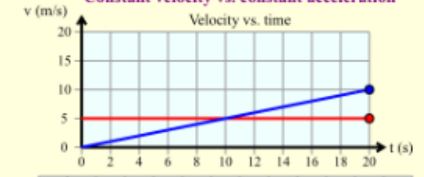1. What is the shape of Car One’s slope? Why? 2. What is the slope of Car Two (numerical answer)? Show work . 3. When does Car Two begin to move faster than Car One? 4. How fast is Car Two moving when it catches Car One?
1. What is the shape of Car One’s slope? Why? 2. What is the slope of Car Two (numerical answer)? Show work . 3. When does Car Two begin to move faster than Car One? 4. How fast is Car Two moving when it catches Car One?
College Physics
11th Edition
ISBN:9781305952300
Author:Raymond A. Serway, Chris Vuille
Publisher:Raymond A. Serway, Chris Vuille
Chapter1: Units, Trigonometry. And Vectors
Section: Chapter Questions
Problem 1CQ: Estimate the order of magnitude of the length, in meters, of each of the following; (a) a mouse, (b)...
Related questions
Question
1. What is the shape of Car One’s slope? Why?
2. What is the slope of Car Two (numerical answer)? Show work .
3. When does Car Two begin to move faster than Car One?
4. How fast is Car Two moving when it catches Car One?

Transcribed Image Text:### Constant Velocity vs. Constant Acceleration
#### Graph Overview
The educational graph displayed represents a comparison between constant velocity and constant acceleration in a velocity vs. time scenario. It showcases two cars, Car 1 (red line) and Car 2 (blue line), over a 20-second time frame.
#### Velocity vs. Time Graph
- **Y-Axis (Vertical):** Velocity in meters per second (m/s), ranging from 0 to 20 m/s.
- **X-Axis (Horizontal):** Time in seconds (s), ranging from 0 to 20 seconds.
- **Red Line (Car 1):** Indicates constant velocity. Car 1 maintains a steady velocity of 5 m/s.
- **Blue Line (Car 2):** Represents constant acceleration. Car 2 starts from rest (0 m/s) and accelerates uniformly, reaching a velocity of 10 m/s at 20 seconds.
#### Position Graph
Below the velocity vs. time graph, a position graph is shown:
- **X-Axis (Horizontal):** Position in meters (m), ranging from -30 to 100 meters.
- **Red Dots:** Correspond to Car 1, with a constant position change over time.
- **Blue Dots:** Represent Car 2, showing accelerated displacement over time.
#### Initial Conditions
- **Car 1 (Red):**
- Initial Position: -30 meters
- Velocity: Set constant at 5 m/s
- **Car 2 (Blue):**
- Acceleration: Set constant at 0.5 m/s²
#### Controls
- **Play/Pause:** Start or stop the simulation.
- **Step/Back Step:** Move the simulation forward or backward step by step.
- **Reset:** Restore initial conditions.
#### Graph Options
- **Position vs. Time**
- **Velocity vs. Time**
This interactive simulation visually distinguishes the dynamics of constant velocity and constant acceleration, providing an educational tool for understanding basic kinematic concepts.
Expert Solution
Step 1

1.
Step by step
Solved in 2 steps with 1 images

Knowledge Booster
Learn more about
Need a deep-dive on the concept behind this application? Look no further. Learn more about this topic, physics and related others by exploring similar questions and additional content below.Recommended textbooks for you

College Physics
Physics
ISBN:
9781305952300
Author:
Raymond A. Serway, Chris Vuille
Publisher:
Cengage Learning

University Physics (14th Edition)
Physics
ISBN:
9780133969290
Author:
Hugh D. Young, Roger A. Freedman
Publisher:
PEARSON

Introduction To Quantum Mechanics
Physics
ISBN:
9781107189638
Author:
Griffiths, David J., Schroeter, Darrell F.
Publisher:
Cambridge University Press

College Physics
Physics
ISBN:
9781305952300
Author:
Raymond A. Serway, Chris Vuille
Publisher:
Cengage Learning

University Physics (14th Edition)
Physics
ISBN:
9780133969290
Author:
Hugh D. Young, Roger A. Freedman
Publisher:
PEARSON

Introduction To Quantum Mechanics
Physics
ISBN:
9781107189638
Author:
Griffiths, David J., Schroeter, Darrell F.
Publisher:
Cambridge University Press

Physics for Scientists and Engineers
Physics
ISBN:
9781337553278
Author:
Raymond A. Serway, John W. Jewett
Publisher:
Cengage Learning

Lecture- Tutorials for Introductory Astronomy
Physics
ISBN:
9780321820464
Author:
Edward E. Prather, Tim P. Slater, Jeff P. Adams, Gina Brissenden
Publisher:
Addison-Wesley

College Physics: A Strategic Approach (4th Editio…
Physics
ISBN:
9780134609034
Author:
Randall D. Knight (Professor Emeritus), Brian Jones, Stuart Field
Publisher:
PEARSON